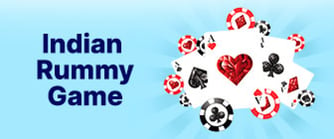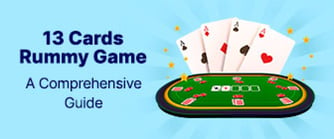21 Card Rummy Game: A Brief Introduction
Once you have mastered 10 card rummy and 13 card rummy, you are ready to move on to the big leagues. You now have the experience to take on 21 card rummy, the king of all rummy versions. Without a doubt, it is one of the most challenging types of rummy. Each round takes a lot of time, patience, and strategizing. If you are new to the world of rummy, then you had better not start with 21 card rummy. A lot of rules, nuances, and tips need to be kept in mind to triumph in 21 card rummy.
Not much is known about the origin of 21 cards rummy. Its ancestor, like all other variants of rummy, is conquain. It is possibly descended from points rummy because the same format is followed for 21 card rummy.
Since rummy is now online and has quickly evolved to become one of India’s most-loved online games, you can play 21 cards rummy on virtual sports apps as well. But, before you dabble in 21 card rummy, you should learn a little more about this thrilling but challenging card game.
Terminology Used in 21 Card Rummy Game
Players should be conversant with the terms used in 21 Card Rummy. The following are some terminologies used often in 21 Card Rummy:
- Pure Sequence: A pure sequence is three or more cards in a row of the same suit without any jokers. To declare a hand legitimate, at least one pure sequence is required.
- Impure Sequence: A sequence containing a joker is considered impure. A joker is used to fill in for any missing cards, comprising three or more cards in a row of the same suit.
- Set: A collection of three or four cards with the same rank but different suits is called a set. Jokers are another component of sets.
- Declaration: Arrange the cards into sets and sequences to declare your hand legitimate.
- Show: All sets and sequences are made visible when a player announces their hand and lays it out on the board.
- Meld: A player-created valid meld is a mix of sets and sequences.
- Drop: When a player elects to leave the game and decides not to play a particular hand any longer.
- Closed Deck: The group of cards still face-down after the players are dealt their first hand. During their turns, players may draw cards from the closed deck.
- Open Deck: The collection of face-up cards made by players after discarding their hands' worth of cards. During their turns, players can draw the top card from the open deck or select a card from the closed deck.
- Joker: One or two jokers are used in 21 Card Rummy as wild cards that may be used instead of any other card to build sets or sequences.
For 21 Card Rummy games and successful communication, it is necessary to comprehend these phrases. Understanding the lingo helps players plan their strategies, make wise judgments, and easily play.
How to play 21 Card Rummy?
Each player is dealt 21 cards at random. Now, these cards have to be arranged following specific rules to win a round of 21 card rummy. There are several ways you can arrange your 21 cards to win:
1) Three pure sequences (three or more consecutive cards of the same suit without a Joker) and the remaining cards into any combination of sets and sequences.
2) Eight Jokers in one group
3) Eight dublees (a dublee is a pair of two cards of the same rank and suit or two Jokers) in eight different groups
4) 3 tunnelas (a tunnela is three cards of the same rank and suit) in three different groups
So, you see, winning a round of 21 card rummy is much more complicated than say, 13 card rummy, where you just have to form two sequences (at least one pure sequence) and the remaining cards need to be melded into any number of sets and sequences.
Jokers are used in 21 cards rummy. After all the players have been dealt their cards, the topmost card from the facedown stack (closed deck) is designated as the Joker. All the cards of the same rank from all four suits also become Jokers. These are Sterling Jokers. There will also be three printed Jokers (one from each deck). These Jokers are Cut Jokers. All of these Jokers can take the place of any missing card while forming valid sets and sequences.
There are also Upper Jokers and Lower Jokers. Suppose, 6 of Hearts is your Sterling Joker. If you have 5 of Clubs and 7 of Clubs, then 5 of Clubs is your Lower Joker and 7 of Clubs is your Upper Joker. If you get a Joker (of the same suit) as well as an Upper Joker and a Lower Joker, then you will form what is called Marriage. In 21 cards rummy, you win points. Each Marriage will earn you 100 points. Remember, in 21 cards rummy, your score can’t go below 120 points or you would be disqualified.
21 Cards Rummy Rules
The rules of 21 card rummy games are similar to the usual Indian rummy games, however, there are some dissimilarities in declaring the cards. The following are the rules of 21 card rummy game that you must know before playing the game:
- In 21 cards rummy, you need to create at least 3 pure sequences and the remaining cards can feature combinations of valid sets or sequences. A tunnela is also treated as a pure sequence in this game. The term is referred to three cards of the same suit, having the same series. For instance, 3♥3♥3♥ is a valid tunnela in 21 cards rummy.
- Kindly note that you must make at least 3 tunnelas of separate groups, and the remaining cards can be combined in a single group or even left unchanged.
- In the 21-card rummy, the dublee is a set of two cards having the same rank and suit, like 9♣ 9♣. Eight dublees are equivalent to three pure sequences and you can leave the remaining cards. Remember that each of these pairs is arranged in individual groups during the declaration.
- You can have 8 jokers in a single group during declaration. You can avoid arranging them in a specific order.
How Does Drop Work in 21 Cards Rummy
While playing rummy, the drop is a crucial step as it helps in playing safe. The following are the steps to be kept in mind during 21 cards rummy:
The 21 cards rummy game gives all the players options to drop out. However, dropping out at different levels have various impacts. There following are the types of drops available in rummy:
First drop - The first drop is when a challenger decides to drop even before picking or discarding cards, in the very first round. This brings a penalty of 30 points to the player.
Middle drop - The middle drop in a rummy game is when the player picks one or more cards and then decides to drop. In such a case, the player gets a penalty of 70 points.
NUMBER OF DECKS IN 21 CARDS RUMMY
21 card rummy or Indian marriage rummy is played with three decks. Each deck has the standard 52 cards categorized into four suits - Diamonds, Clubs, Spades, and Hearts. There is one printed Joker in each deck.
A minimum of two to a maximum of six players can participate in 21 card rummy.
Calculating scores in 21 Cards Rummy
A crucial aspect of 21 Card Rummy is calculating scoring. It aids in selecting the victor and offers a clear picture of each Player's performance. Here is a thorough description of the 21 Card Rummy scoring system:
Cards are given points:
- Number cards (2–10): Each number card is worth the same points as it does on the face. The 2 of Hearts, for instance, is worth 2 points, and the 7 of Diamonds is worth 7.
- Picture cards (10 points each): These include the Ace, King, Queen, and Jack.
- Jokers: Jokers, both printed and wild, are worth 0 points.
Points calculation for unmatched cards (Deadwood): - Only cards that are unmatched count toward the point total.
- Total the points on each Player's hand for all the unmatched cards.
How to calculate points for valid sets and sequences:
- A player receives zero (no points) for the round if they successfully combine all of their cards into valid sets and sequences.
- The Player who declares with a legitimate hand obtains a score of zero, regardless of the points in the unmatched cards of other players.
- A valid meld comprises a pure sequence (without a joker) and impure sequences (with
Scoring for losers:
- Losers are awarded points depending on the combined value of their unpaired cards.
- They are totaled together to determine each non-winning Player's score for the round.
Score of the winning Player:
- Since all their cards were properly melded, the victorious Player obtains a score of zero.
Cumulative scoring:
- In games with several rounds, points are added up when each round is completed. Each Player's overall score is the total of their round scores.
Deciding the Winner: - At the end of the game or a predetermined number of rounds, the Player with the lowest cumulative score is declared the Winner.
- The participant who consistently performs and uses the same approach over many rounds earns the lowest cumulative score.
It's vital to remember that the particular rules and scoring procedures may change depending on the variants and house rules decided upon by the participants. It is advised to create explicit rules and scoring procedures before the game begins to prevent misunderstandings or disputes.
Accurate score calculation is essential for 21 Card Rummy play and selecting the Winner. Players may plan well and attempt to attain the lowest score to win by keeping track of their points and comprehending the scoring system.
How Winner Decided in Rummy
In rummy, the following criteria are used to select the Winner:
- Melding: The Winner is the Player who melds all their cards into legal sets and sequences.
- Declaration: After melding all their cards, players must declare their hand to show they have a legal arrangement of sets and sequences.
- Validity Check: Following the declaration, the other players examine the declaring Player's melds to ensure they are legitimate and satisfy the requirements.
- Points Calculation: Based on the value of the cards, the remaining players add up the points in their hands if the declaration is legitimate. The Winner is the Player with the fewest points.
The Winner of the rummy game is the person with the lowest point total who successfully melds their cards and announces a legal hand.
How to Identify Non-Winning Player in 21 Card Rummy
Finding the losing Player in 21 Card Rummy is essential to figuring out who wins. Here are various methods for identifying the loser:
- Calculating Points: Following the declaration of a player's hand, the other players must determine their hands' points based on the worth of the cards. The participant who has accrued the most points is regarded as the loser.
- Invalid Declaration: A player becomes the loser if they declare their hand, but their melds are later determined to be invalid. Their hand is deemed void if they have not created the necessary number of valid sets and sequences.
- Unfinished Melds: A player is deemed the loser if they cannot complete the necessary number of sets and sequences and fail to reveal their hand within the allotted time.
- Excessive Deadwood: Unmatched cards in a player's hand that do not contribute to melds are called deadwood. A player's point total will be more significant, and their chances of being the loser will rise if they have a substantial number of high-value or mismatched cards.
- Last Player Standing: If all players have left the game by electing not to play their hand, save for one, the surviving Player is immediately declared the loser. This may happen if every other Player has left the game due to poor cards or gaming circumstances.
In 21 Card Rummy, identifying the loser is crucial to choosing the Winner. It guarantees fair play by clearly identifying the person with the fewest points as the game's Winner.
How to Calculate Winning Amount
The number of points the losing players have amassed is often used to determine the rummy winning sum. While the other participants contribute to the winning sum, the Player with the fewest points is proclaimed the Winner.
The sum of the non-winning players' points determines the winning amount. The predetermined rupee value per point, which is decided upon before the game's commencement, is then multiplied by the total number of points. The sum that results is the winning sum given to the game's victor.
The winning sum calculation may change depending on the particular regulations and agreements reached among the participants.
TIPS AND TRICKS TO WIN 21 CARD RUMMY
The following are the tips and tricks that help in being an expert on 21-card rummy:
1. Knowing the rules - The 21 cards rummy has specific rules that you must understand to make a valid declaration. Elements like tunnelas, dublees, etc. make the game easier and give more options for forming combinations.
2. Arranging the cards - As soon as the cards are dealt with, the prime thing is to arrange them according to the expected combinations. This gives you a better chance of keeping a track of which card you need to pick or discard. This helps in creating useful combinations and avoiding waste of time.
3. Create pure sequences as early as possible - The first step that takes you towards forming a valid declaration is making pure sequences as early as possible. Check the cards in your hand and try to combine consecutive cards of the same suit.
4. Try to keep smart cards in your hand - There are some numbers that can be added in different combinations. For instance, if you have 6 of a suit, it can be combined with 4,5,6 or 5,6,7, or even 6,7,8. Such cards help in creating different kinds of combinations and are known as smart cards.






















